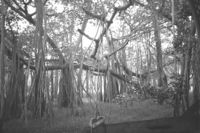Difference between revisions of "Banyan Tree"
(Created page with '(''Ficus benghalensis''). The Banyan tree located on the Theosophical Society (TS) estate at Adyar, near Chennai in India is quite celebrated as one of the biggest in the souther…') |
|||
| Line 1: | Line 1: | ||
| + | [[image:TE_BanyanTree.jpg|thumb|200px|<center>''Banyan Tree at compound of Theosophical Society, Adyar, India''</center>]] | ||
| + | |||
(''Ficus benghalensis''). The Banyan tree located on the Theosophical Society (TS) estate at Adyar, near Chennai in India is quite celebrated as one of the biggest in the southern hemisphere and is a tourist attraction. The Banyan is a most unusual tree which spreads by putting down aerial roots which, when they reach the ground, take root in the soil and then thicken into trunks. This process is repeated many times so that the original tree may extend over a very large area. | (''Ficus benghalensis''). The Banyan tree located on the Theosophical Society (TS) estate at Adyar, near Chennai in India is quite celebrated as one of the biggest in the southern hemisphere and is a tourist attraction. The Banyan is a most unusual tree which spreads by putting down aerial roots which, when they reach the ground, take root in the soil and then thicken into trunks. This process is repeated many times so that the original tree may extend over a very large area. | ||
Revision as of 01:43, 10 March 2012
(Ficus benghalensis). The Banyan tree located on the Theosophical Society (TS) estate at Adyar, near Chennai in India is quite celebrated as one of the biggest in the southern hemisphere and is a tourist attraction. The Banyan is a most unusual tree which spreads by putting down aerial roots which, when they reach the ground, take root in the soil and then thicken into trunks. This process is repeated many times so that the original tree may extend over a very large area.
Helena P. BLAVATSKY in her Isis Unveiled wrote, “The Serpent, the Tree of Knowledge of Good and Evil, and the Tree of Life, are all symbols transplanted from the soil of India. The Arasa Maram, the banyan tree, so sacred with the Hindus, since Vishnu, during one of his incarnations, reposed under its mighty shade, and there taught humanity philosophy and sciences is called the Tree of Knowledge and the Tree of Life” (IU II:293).
© Copyright by the Theosophical Publishing House, Manila
